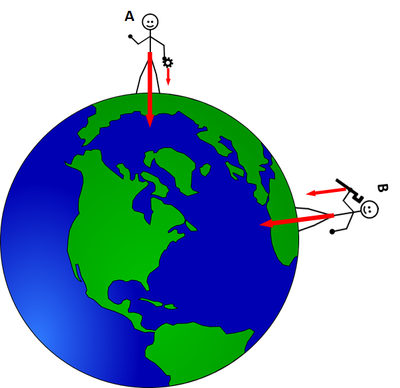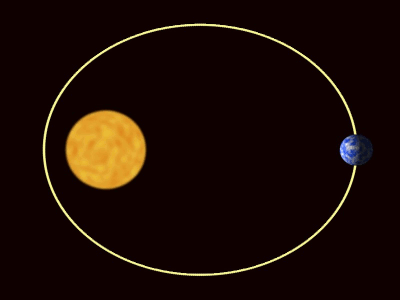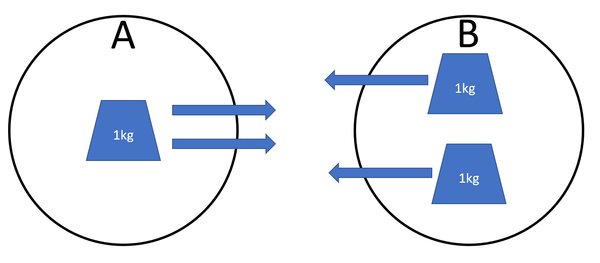Difference between revisions of "Gravity"
(→About Gravity) |
|||
| Line 32: | Line 32: | ||
: [[Gravity]] is a [[Non-contact Force|non-contact force]] because it can act without [[object]]s touching. | : [[Gravity]] is a [[Non-contact Force|non-contact force]] because it can act without [[object]]s touching. | ||
: All [[object]]s are affected by [[gravity]]. | : All [[object]]s are affected by [[gravity]]. | ||
| − | : [[Gravity]] is the [[force]] that pulls | + | : [[Gravity]] is the [[force]] that pulls [[object]]s to the ground. |
: [[Isaac Newton]] was the first to realise that [[gravity]] is the [[force]] that holds the [[planet]]s in [[orbit]] around [[The Sun]]. | : [[Isaac Newton]] was the first to realise that [[gravity]] is the [[force]] that holds the [[planet]]s in [[orbit]] around [[The Sun]]. | ||
: The [[force]] of [[gravity]] between two [[object]]s is always equal in [[magnitude]] but opposite in direction. | : The [[force]] of [[gravity]] between two [[object]]s is always equal in [[magnitude]] but opposite in direction. | ||
| Line 41: | Line 41: | ||
| style="height:20px; width:200px; text-align:center;" |[[Object]] A has 1[[kg]] of [[mass]] and is [[attract]]ed to [[object]] B. [[Object]] B has 2[[kg]] of [[mass]] and is [[attract]]ed to [[object]] A. The [[force]] acting on [[object]] A is the same as the [[force]] on [[object]] B. | | style="height:20px; width:200px; text-align:center;" |[[Object]] A has 1[[kg]] of [[mass]] and is [[attract]]ed to [[object]] B. [[Object]] B has 2[[kg]] of [[mass]] and is [[attract]]ed to [[object]] A. The [[force]] acting on [[object]] A is the same as the [[force]] on [[object]] B. | ||
|} | |} | ||
| − | |||
===Falling=== | ===Falling=== | ||
Revision as of 11:03, 6 February 2019
Contents
Key Stage 2
Meaning
Gravity is a force that causes all objects to be attracted to each other.
About Gravity
- Gravity is a non-contact force.
- Gravity affects all objects.
- Gravity pulls us down towards the centre of the Earth.
| If person A drops the cog it will fall towards the centre of the Earth. If person B drops the spanner it will fall towards the centre of the Earth. |
| The planets are pulled towards the The Sun by gravity. |
Key Stage 3
Meaning
Gravity is a force that causes all objects with mass to be attracted to each other.
About Gravity
- Gravity is a force so it is measured in Newtons.
- Gravity is a non-contact force because it can act without objects touching.
- All objects are affected by gravity.
- Gravity is the force that pulls objects to the ground.
- Isaac Newton was the first to realise that gravity is the force that holds the planets in orbit around The Sun.
- The force of gravity between two objects is always equal in magnitude but opposite in direction.
| Object A has 1kg of mass and is attracted to object B. Object B has 2kg of mass and is attracted to object A. The force acting on object A is the same as the force on object B. |
Falling
Energy Transfers
Accelerating
- When an object accelerates towards the ground energy is transferred from the gravitational potential energy store of the object to the kinetic energy store of the object.
Decelerating
- When an object decelerates away from the ground energy is transferred from the kinetic energy store of the object to the gravitational potential energy store of the object.
Forces
Accelerating
- When an object accelerates towards the ground gravity is causing a mechanical energy transfer.
Decelerating
- When an object decelerates away from the ground gravity is causing a mechanical energy transfer.
Orbits
- Newton was the first person to realise that objects were held in orbit by gravity which he explained in his Universal Theory of Gravitation.
- Moons orbit planets and planets orbit the stars due to gravity.
- Gravity is a constant force directed to the centre of a massive object.
- The Moon feels a force pulling it towards the centre of the Earth. The Earth feels a force equal in magnitude but opposite in direction to that of The Moon.
| The planets are pulled towards The Sun by gravity. |


